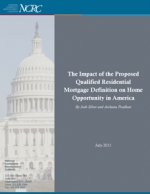The Impact of the Proposed Qualified Residential Mortgage Definition on Home Opportunity in America
 Financial institutions will be exempt from the 5 percent risk retention requirement on certain types of mortgages, known as Qualified Residential Mortgages (QRMs). QRMs contain loan terms and practices that the regulatory agencies have determined are less likely to end up in default. The regulatory agencies have appropriately specified a series of risky loan terms and practices that cannot be in QRMs such as prepayment penalties and a lack documentation of borrower income. However, the agencies have proposed down payment requirements of up to 20 percent for QRMs. This requirement will effectively disqualify large numbers of moderate- and middle-income families from buying homes. The proposed guidelines for debt-to-income ratios are also unduly restrictive and will shut out broad segments of the population.
Financial institutions will be exempt from the 5 percent risk retention requirement on certain types of mortgages, known as Qualified Residential Mortgages (QRMs). QRMs contain loan terms and practices that the regulatory agencies have determined are less likely to end up in default. The regulatory agencies have appropriately specified a series of risky loan terms and practices that cannot be in QRMs such as prepayment penalties and a lack documentation of borrower income. However, the agencies have proposed down payment requirements of up to 20 percent for QRMs. This requirement will effectively disqualify large numbers of moderate- and middle-income families from buying homes. The proposed guidelines for debt-to-income ratios are also unduly restrictive and will shut out broad segments of the population.
There’s no good reason to require high downpayments. This analysis
also reveals that foreclosure rates do not differ substantially between the proposed QRM definition and the alternative definitions. In 2006, for example, QRM loans had a foreclosure rate of .14 percent, but the same loans with down payments as low as 3 percent had a foreclosure rate only inches up to .26 percent. This tiny rate of foreclosure compares to subprime loans that had default rates of over 50%. Read the white paper online.


